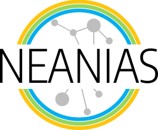If you are reading this, you probably already know that one of the main goals of the NEANIAS space services is providing efficient solutions to deal with the data tsunami that will be produced by the next-generation all-sky surveys, with a special focus on the radio ones. With the square kilometer array (SKA) just around the corner, its pathfinders and precursors are already providing a glimpse of what to expect in the coming years.
In particular, instruments such as MeerKAT in South Africa or ASKAP in Australia, thanks to their excellent sensitivity, angular resolution and survey speed, are pushing forward our knowledge of the radio sky, revealing a plethora of previously undetected radio sources, both galactic and extragalactic. But what is exactly a radio source, you might ask? Well, to answer such a question, nothing better than a quick tour to discover what we see when we look at the sky with “radio glasses”.
Telescopes detect electromagnetic radiation -that means light- that is produced by astrophysical phenomena. Different phenomena emit light at different wavelengths. This is crucial because it gives birth to the different branches of observational astronomy: we have high-energy astrophysics (dealing with gamma and X-rays), UV, optical and infrared astronomy and, for the sake of this article, radio astronomy. Each branch provides a different piece of information about the processes and sources we study, so they are complementary: this is the power of multi-wavelength astronomy. Visible light (the one our eyes can catch) has a wavelength roughly comprised between 400 and 700 nanometers. Likewise, wavelengths around a millimeter and longer are considered radio wavelengths, and they have a fundamental advantage over other wavelengths: they can pass through the Earth’s atmosphere quite easily, pretty much like visible light. This means that, while the atmosphere is relatively opaque to the infrared, or (happily for us) the UV, radio waves can reach the surface almost unaltered. This is the so-called radio window, the main reason we can have our radio observatories on the ground, instead of putting them in orbit – which would be much more expensive and inefficient.
